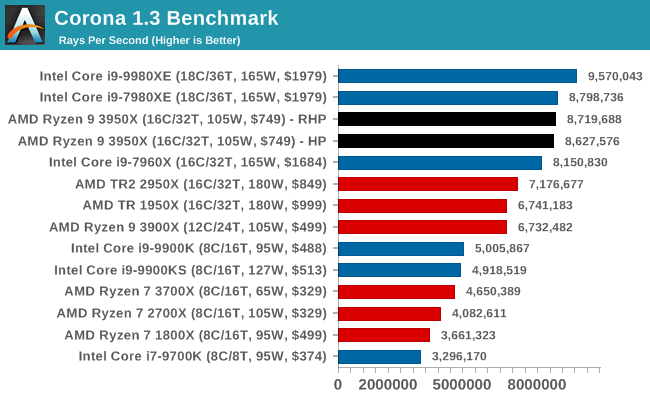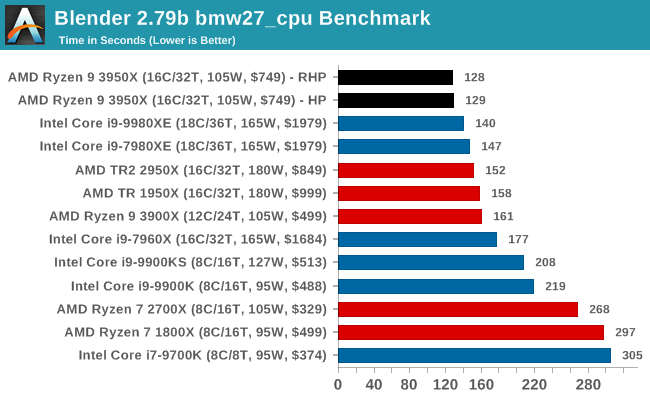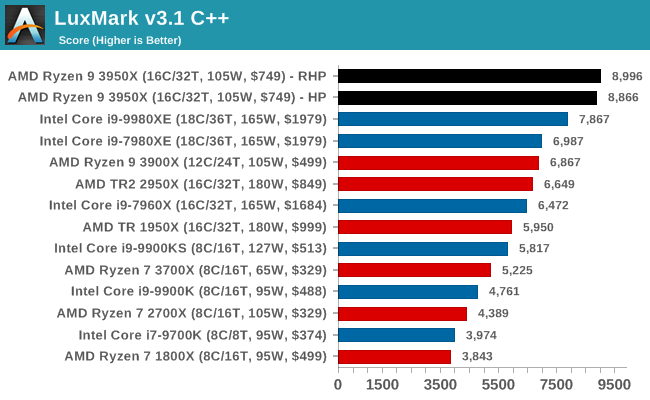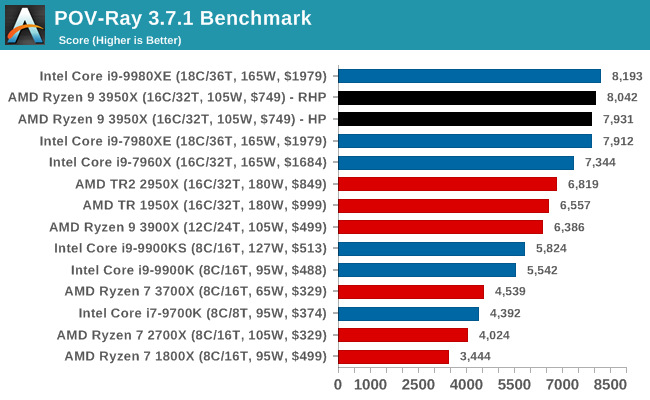The AMD Ryzen 9 3950X Review: 16 Cores on 7nm with PCIe 4.0
by Dr. Ian Cutress on November 14, 2019 9:00 AM ESTCPU Performance: Rendering Tests
Rendering is often a key target for processor workloads, lending itself to a professional environment. It comes in different formats as well, from 3D rendering through rasterization, such as games, or by ray tracing, and invokes the ability of the software to manage meshes, textures, collisions, aliasing, physics (in animations), and discarding unnecessary work. Most renderers offer CPU code paths, while a few use GPUs and select environments use FPGAs or dedicated ASICs. For big studios however, CPUs are still the hardware of choice.
All of our benchmark results can also be found in our benchmark engine, Bench.
Corona 1.3: Performance Render
An advanced performance based renderer for software such as 3ds Max and Cinema 4D, the Corona benchmark renders a generated scene as a standard under its 1.3 software version. Normally the GUI implementation of the benchmark shows the scene being built, and allows the user to upload the result as a ‘time to complete’.
We got in contact with the developer who gave us a command line version of the benchmark that does a direct output of results. Rather than reporting time, we report the average number of rays per second across six runs, as the performance scaling of a result per unit time is typically visually easier to understand.
The Corona benchmark website can be found at https://corona-renderer.com/benchmark

Intel's HEDT chips are quite good at Corona, but if we compare the 3900X to the 3950X, we still see some good scaling.
Blender 2.79b: 3D Creation Suite
A high profile rendering tool, Blender is open-source allowing for massive amounts of configurability, and is used by a number of high-profile animation studios worldwide. The organization recently released a Blender benchmark package, a couple of weeks after we had narrowed our Blender test for our new suite, however their test can take over an hour. For our results, we run one of the sub-tests in that suite through the command line - a standard ‘bmw27’ scene in CPU only mode, and measure the time to complete the render.
Blender can be downloaded at https://www.blender.org/download/

AMD is taking the lead in our blender test, with the 16-core chips easily going through Intel's latest 18-core hardware.
LuxMark v3.1: LuxRender via Different Code Paths
As stated at the top, there are many different ways to process rendering data: CPU, GPU, Accelerator, and others. On top of that, there are many frameworks and APIs in which to program, depending on how the software will be used. LuxMark, a benchmark developed using the LuxRender engine, offers several different scenes and APIs.
In our test, we run the simple ‘Ball’ scene on both the C++ code path, in CPU mode. This scene starts with a rough render and slowly improves the quality over two minutes, giving a final result in what is essentially an average ‘kilorays per second’.

Despite using Intel's Embree engine, again AMD's 16-cores easily win out against Intel's 18-core chips, at under half the cost.
POV-Ray 3.7.1: Ray Tracing
The Persistence of Vision ray tracing engine is another well-known benchmarking tool, which was in a state of relative hibernation until AMD released its Zen processors, to which suddenly both Intel and AMD were submitting code to the main branch of the open source project. For our test, we use the built-in benchmark for all-cores, called from the command line.
POV-Ray can be downloaded from http://www.povray.org/

POV-Ray ends up with AMD 16-core splitting the two Intel 18-core parts, which means we're likely to see the Intel Core i9-10980XE at the top here. It would have been interesting to see where an Intel 16-core Core-X on Cascade would end up for a direct comparison, but Intel has no new 16-core chip planned.











206 Comments
View All Comments
drunkenmaster - Thursday, November 14, 2019 - link
That's not really how it works. 10nm for Intel is struggling for clock speed and yields but more importantly the architecture remains fairly close to the same overall. What architecture gains they made they appear to be losing in clock speed.The only really big advantage AMD has from 7nm TSMC, aside from also lower clocks, is die size. They can fit 16 cores into a die size that Intel can, but can't easily. Frankly the only direct benefit Intel will get from 10nm is the fact that a similar 16 core chip would hopefully use the same power as AMDs, though with the way their 10nm is working due to poor yields and lacking clock speeds they would likely up the voltage to push clock speeds as high as possible and well, there is a reason their 10/12 core stuff isn't coming out on 10nm any time soon.
AMD gained performance on architecture but they were already close to this competitive with their 8 core 14nm chip (a worse than Intel 14nm node). As with what Intel would gain, AMD gained in performance/watt and die size, the actual competitiveness of their chips is purely due to being a competitive architecture. Intel won't magically destroy them, they'll be in the same ballpark.
This is the thing people have been kind of weird about, a year ago Zen 1 wasn't far behind Intel on a significantly worse '14nm' node that was more like a lets say 18nm node and Intel had the best 14nm node by a mile. While AMD have a headstart on better nodes when Intel gets to 10nm it's only in the same ballpark as TSMC 7nm. Even when Intel finally make the leap they are only gaining parity with TSMC, not an advantage and their architectural advantage is not really there. With Icelake the only 'win' is AVX512, which is basically unused for the home market.
10nm won't enable Intel to destroy anyone, if their 10nm started working well it would enable them to drop to similar power usage as AMD and offer similar core counts in the same die sizes, the architectures are close enough that the chips would be pretty damn close in overall performance.
Though that's assuming Intel managed a 16 core with a ringbus which is one of the major reasons for it's competitiveness in areas like gaming. If they have to go to a mesh for 16 core then they lose that advantage.
Spunjji - Thursday, November 14, 2019 - link
Solid assessment. Thanks for the post :)lobz - Thursday, November 14, 2019 - link
My dear friend, intel's 10nm chips will not be superior in performance, because they can't hit either the same core count or the frequency needed to let the high IPC matter. Also, by the time intel's 7nm comes out, AMD will have a better than the current process and an even faster architecture. We're speaking at least 2 years from now. Destroy AMD's chips? Good luck.drothgery - Thursday, November 14, 2019 - link
Except at the highest core counts (on the desktop, HEDT, and server), Intel has much more of a pricing problem with Ryzen than a performance problem.Phynaz - Thursday, November 14, 2019 - link
I would say AMD has the pricing problem, as Intel sets their own price, where AMD has to react to intel.Death666Angel - Friday, November 15, 2019 - link
Intel: "We just decided to drop the 10xxx HEDT pricing by 50% or so. No reaction to any of our competitors. Totally our own decision. Move along, nothing to see here." I get that.Qasar - Saturday, November 16, 2019 - link
intel sets its own price, maybe before, but not now. as Death666Angel said, intel didn't drop the price of its 10xx series cpus cause they were being nice, it was because they can't charge that much any more.John_M - Monday, November 25, 2019 - link
That's such a dumb argument. If course they'll be competitive on price if they are priced to compete! You can say that about anything. The sentence reduces to nothing.AIV - Thursday, November 14, 2019 - link
Market pricing for intel HEDT processors have already halved. eg. i9-9980XE is now available for ~1050EUR. See https://geizhals.eu/intel-core-i9-9980xe-extreme-e... .Jorgp2 - Thursday, November 14, 2019 - link
That's retailers lowering prices to clear stock, has nothing to do with Intel